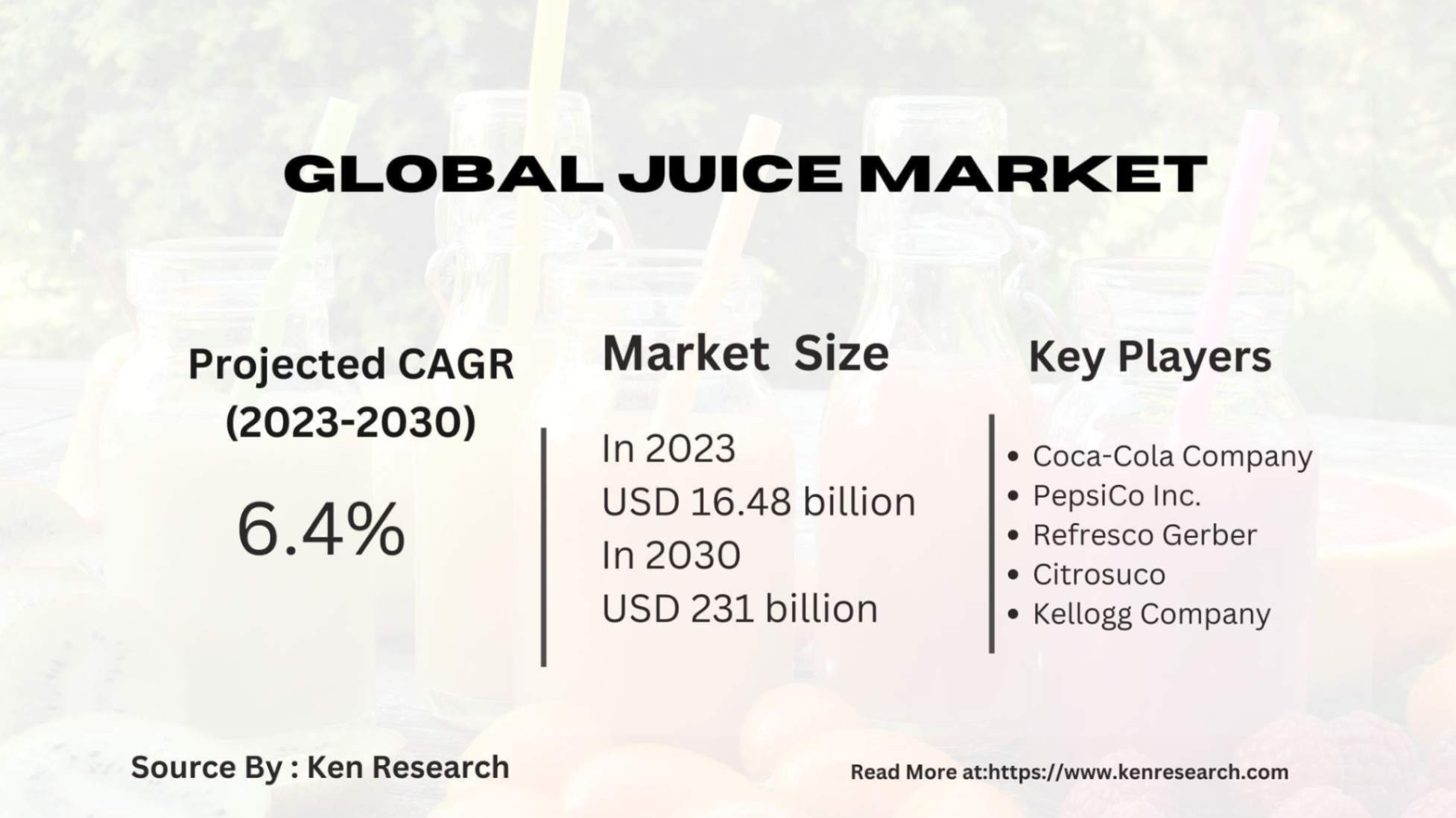The Industry Analysis of Global Juice Market

For many, a glass of juice evokes images of a healthy breakfast or a refreshing afternoon pick-me-up. But beyond the delicious taste, the juice market is a multi-billion dollar industry with a fascinating story to tell.
The global juice market is estimated to reach a staggering USD 231 billion by 2030, reflecting a steady CAGR (Compound Annual Growth Rate) exceeding 6.4% from a valuation of USD 16.48 billion in 2023.
Growth Drivers
This growth can be attributed to several key factors:
- Health and Wellness Concerns: Consumers are increasingly drawn to beverages perceived as healthy, with juice offering a source of essential vitamins and minerals.
- Convenience: Juice offers a convenient and readily available way to incorporate fruits and vegetables into one’s diet.
- Innovation in Packaging: Advancements in aseptic packaging technologies extend shelf life and reduce spoilage, making juice more accessible to a wider range of consumers.
- Rising Disposable Incomes: As disposable incomes rise globally, particularly in developing economies, consumers are more likely to include processed beverages like juice in their diets.
Market Segmented
The juice market segmentation based on various factors, ensuring a wide range of options to cater to diverse needs and preferences:
- Fruit and Vegetable Juice: This segment dominates the market, with fruit juices like orange, apple, and grape being popular choices. Vegetable juices, gaining traction for their potential health benefits, are a growing niche within this segment.
- Cold-Pressed Juice: This segment focuses on minimally processed juices extracted using a hydraulic press, preserving more nutrients and creating a thicker consistency. Cold-pressed juices are often perceived as a healthier and more natural option, appealing to health-conscious consumers.
- Organic Juices: This segment caters to consumers seeking organic fruits and vegetables, free from synthetic pesticides and fertilizers, in their juice. Organic juices typically come with a premium price tag.
- Functional Juices: This emerging segment incorporates functional ingredients like vitamins, minerals, and antioxidants, catering to consumers seeking additional health benefits beyond basic fruit or vegetable content.
Take a look at: The Growth and SWOT Analysis of Cold-Pressed Juice Market
Top Players of Juice Industry
The global juice market is dominated by a few major players, with a significant portion controlled by:
- Coca-Cola Company (Estimated market share: 18-22%): A beverage giant with a strong presence in the juice market through its Minute Maid brand, offering a wide range of fruit and vegetable juice options.
- PepsiCo Inc. (Estimated market share: 20-25%): Another major player with its Tropicana brand, offering a variety of fruit juice options, including pulp-free and not-from-concentrate varieties.
- Refresco Gerber (Estimated market share: 5-10%): A leading producer of private label juice products for supermarkets and retailers, offering a cost-effective alternative to major brands.
- Citrosuco (Estimated market share: 10-15%): The world’s largest orange juice processor, with a dominant presence in the orange juice segment, particularly in concentrated forms.
- Kellogg Company (Estimated market share: 3-5%): While primarily known for cereals, Kellogg’s has a significant presence in the juice market through its Smoothie-On-The-Go brand, offering convenient and portable fruit and vegetable juice blends.
Emerging Trends in Juice Sector
The juice market is constantly evolving, with several key trends shaping its future:
- Focus on Natural and Minimally Processed Juices: Consumers are increasingly seeking juices perceived as more natural and minimally processed, driving demand for cold-pressed and fresh-pressed options.
- Functional and Fortified Juices: The incorporation of functional ingredients like probiotics, prebiotics, and adaptogens is gaining traction, catering to consumers seeking additional health benefits beyond basic nutrition.
- Sustainability Concerns: Packaging waste and environmental impact are growing concerns. The use of eco-friendly packaging materials and exploring sustainable sourcing practices will be crucial for responsible juice production.
- Subscription-Based Juice Delivery Services: The convenience of home delivery is leading to the rise of subscription-based services offering fresh-pressed or cold-pressed juice options directly to consumers.
- Personalized and Customized Juices: Emerging technologies may pave the way for personalized juice blends tailored to individual dietary needs and preferences.
Conclusion
The global juice market offers a diverse range of options, catering to various taste buds and health-conscious preferences. While fruit and vegetable juices remain dominant, the rise of cold-pressed, organic, and functional options points towards a growing demand for perceived healthier and more natural choices. The influence of top players and emerging trends like sustainability and personalized solutions will continue to shape the future of this ever-evolving beverage category.
You can also read about : The Growth of Organic Juice Market with Segmentation and Trends
